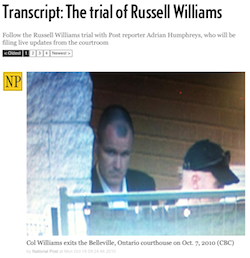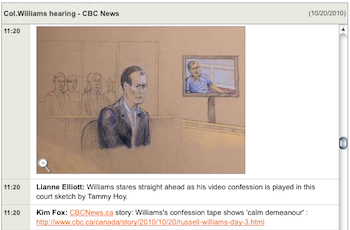Late last month in a Canadian courtroom, Russell Williams, a former high-ranking colonel in the Canadian military, pleaded guilty to the murders of two young women as well as 86 counts of break and enter, sexual assault and other crimes. His sentencing hearing was widely covered by major Canadian media. Here, Canadian online journalism professor Robert Washburn explains how journalists tackled the story, in real-time.
Using social media in journalism is like watching lightning. It can be explained as a physical phenomenon using the laws of physics. Scientists study it and forecast when it will happen. But nobody can predict where it will hit. Nobody can predict the results. More than anything else, nobody can make it hit the same spot twice.
Social media played a significant role during the Russell Williams hearing, as it became a news ticker from inside the courtroom, sharing vivid, often disturbing details of his crimes.
More and more, newsrooms are recognizing the importance of the use of social media like Twitter, Facebook, blogs, and so forth. The American Journalism Review in March reported the influx of social media editors working with citizen journalists, engaging audiences. NYTimes.com and CNN.com, for example, experienced a 300 percent increase in unique visitors via these media.
Yet, social media continues to confound those who want to see reproducible results. Social media is viral and uncontrolled; messages get reworked, reshaped and retweeted, as Toronto Star columnist Antonia Zerbisias pointed out in her post-G20 analysis of the use of Twitter during the protests in Toronto in June.
Rich Gordon, associate professor and director of digital innovation at Medill School of Journalism at Northwestern University, said it best in a recent article in Nieman Reports.
“So this may not be the ideal time to suggest that the social media landscape is continuing to be transformed in ways that journalists and news organizations will find confounding,” he wrote.*
Already there are analyses starting, looking into the ethical dimensions of the use of Twitter during the Williams hearing. It will be up to the media ethicists and other scholars to dissect the content and provide analysis. This article is meant to be an early examination of the role of social media technology and the lessons learned for future applications in journalism.
BlackBerry Ban Lifted
Immediately, it is important to understand the unique context of the Williams hearing. First, a judge lifted a BlackBerry ban and allowed reporters to bring laptop computers and smartphones into the courtroom. This is not always the case in Canada, and is determined by each judge for each case. Hence, this was unusual.
These tools allowed instant communication with the newsroom. It also gave reporters the ability to instantly publish what was going on. Twitter was a popular tool, as some organizations allowed reporters to post to individual accounts or to use aggregator technology like CoveritLive, where a number of reporters, commentators and editors were presenting a stream of information via text and images.
The content was very raw in some instances, as reporters became stenographers, passing along details with little — if any — context or forethought. Twitter technology constrains journalists in this manner, according to Mark Walker, business team leader at Toronto-based real-time content management system ScribbleLive. For one thing, he said in an email to me, messages are limited to 140 characters. It’s also push technology, meaning the audience subscribes and then automatically receives information. It is unedited, unauthenticated and unverified, he argued, breaking three of the major protocols of good journalism.
Sure, the contents of the hearing were compelling. Certainly, there were members of the audience and journalists who found the content repulsive. Still, the way crown attorney (prosecutor) Lee Burgess walked the judge through the evidence, building layer upon layer of detailed evidence, made a word-for-word reporting pretty enticing. This, in turn, became more shocking as it unfolded. It was a challenge for journalists to stop and use news judgment due to the momentum created by this legal strategy. The evidence was presented in such a way as to create a very dramatic narrative as the nature of the crimes and violence escalated. While the technology made it easy to publish, the content smoothed the process as well. Neither the technology nor the news media needed to add anything to make this case sensational. It was inherently sensational.
Beyond Social Media
The high news value of the Williams hearing meant additional resources were given to the coverage. And the technology went beyond social media. While some reporters were alone in the courtroom, platforms like CoveritLive allowed editors and other journalists to contribute to the information stream. Reporters back in the newsroom included contextual background, uploaded photo galleries and provided filler when the streams were slow. In the courtroom, illustrators uploaded their drawings directly to the newsroom’s live feed. CoveritLive also enabled news organizations to incorporate what readers and other Twitter and social media users were saying.

In other cases, CoveritLive was used to hold live, interactive chats with audiences to discuss aspects of the trial. For example, the CBC invited trauma specialists and psychotherapists to discuss the impact of the trial.
Another factor was the high public interest in the case. The coverage of the murders, the investigation, the arrest and the pre-hearing reporting laid the foundation for a large audience seeking more information. Social media was a good channel for audiences because it allowed them to follow details instantly and from anywhere.
Expect To Be Confounded
Twitter is useful to journalists as a form of news ticker, a steady stream of information for audiences. It is good at letting people know up-to-the-minute what is going on in the format of short snippets. But the use of CoveritLive by the Toronto Star, Globe and Mail and CBC (and ScribbleLive by the National Post), among others, mitigated some of the issues raised by using Twitter alone.
In these cases several techniques were used. For example the blending of several Twitter feeds provided varied points of view. In other cases, Twitter messages were combined with other journalists and experts outside the courtroom and in the newsroom, who were able to provide context, images and other information. This added context in some cases and other perspectives, as well. It also made for a single delivery platform for audiences, giving them one channel to receive a wide range of information.
Toronto Star reporter Joanna Smith, who distinguished herself as one of the better Twittering reporters in the country when she used the platform to report from Haiti, was quoted by her own paper in a story about using Twitter to cover the hearing.
“The immediacy of Twitter has a power that both news consumers and journalists are still getting used to harnessing,’‘ she said. “I think of my tweets from Haiti and how crafting a single 140-character tweet that worked as a complete narrative had a power that gave me chills, sometimes, in a way that the same amount of text in a newspaper story would not. I think many of my followers felt the same way about it. I think the same dynamics are at play here, but the content is so graphic that almost any tweet can blow someone away. We have to respect that, and work hard to check and balance ourselves accordingly.”
Is Twitter a useful tool for journalists? No doubt. And, should journalists continue to use social media? Of course. But, as Picard rightly said, we must expect to be confounded. What is most important is journalists should be free to experiment with these new technologies. The Williams hearing was an important crucible to test the use of social media in news coverage in Canada.
We are in a period where innovation can happen spontaneously. New standards are yet to be formed. Journalists must remain open to the possibilities. Still, it should never be viewed as predictable or controllable. Like lightning, journalists will need to understand it, but also stand back and watch.
*Correction (11/3/10): The quote from Rich Gordon was misattributed to Robert Picard. We regret that error.
Prof. Robert Washburn instructs in the new Journalism: Online, Print and Broadcast program at Loyalist College in Ontario, Canada, where he teaches the uses of new technologies in journalism. He is the innovation editor for J-Source.ca, where he launched the Canadian Hyperlocal Journalism Project aimed at building resources to assist those interested in this emerging area. He has worked for more than 25 years as a journalist in newspapers, magazines and radio, and was the first post-secondary educator in Canada to teach in Second Life.

